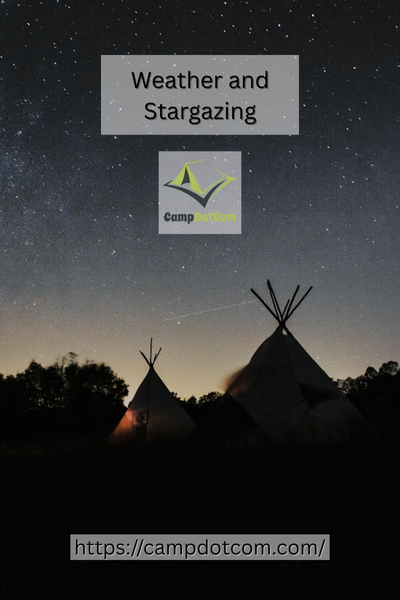When you think about stargazing, what comes to mind? You probably picture a clear, starry night sky—no clouds, no rain, and certainly no light pollution. But here’s the thing: the weather can make or break your stargazing experience. It’s not just about the stars; it’s about what the weather brings with it, and how it sets the stage for your celestial adventure.
Read More About Weather and Stargazing

Weather and Stargazing: It’s All About Timing
I’ll be honest—one of my favorite pastimes is sitting outside, lying back, and staring up at the night sky. There’s something about watching the stars twinkle and the planets slowly drift that puts everything in perspective. But it took me a few botched attempts to learn that the weather plays a huge role in whether you’ll see anything beyond the occasional plane.
More Things to Know About Weather and Stargazing
The first time I tried stargazing in the winter, I was so excited I could hardly stand it. I grabbed my telescope, bundled up in every layer I owned, and trekked out into the yard. As soon as I got out there, though, I realized it was way colder than I’d anticipated, and worse—clouds had rolled in, blocking the stars entirely. Talk about a buzzkill.
As an Amazon Associate, I earn from qualifying purchases. Some of the links in this article are affiliate links. This means that, at zero cost to you, I will earn an affiliate commission if you click through the link and finalize a purchase.
So, after that lesson, I became a lot more intentional about checking the weather before I stargazed. And let me tell you, it makes all the difference.

How Weather Affects Stargazing Conditions
When it comes to stargazing, clear skies are absolutely essential. But there’s more to the weather than just the lack of clouds. Here’s a rundown of how different weather conditions impact your stargazing experience.
Clear Skies: The Ideal Stargazing Weather
This one’s obvious, right? Clear skies mean no clouds to block your view of the stars. You’ll want to stargaze on nights with as little atmospheric interference as possible. That means checking for cloud cover and making sure the forecast is favorable. Apps like Clear Outside or SkySafari are great tools for predicting stargazing weather.
Wind: It’s Not Always Your Friend
Ever tried to set up a telescope on a windy night? It’s tough. Wind can not only mess with the stability of your telescope, but it can also create turbulence in the air that distorts the stars and planets you’re trying to see. On those windy nights, you might end up seeing stars that are blurry or shimmering—definitely not the sharp, crisp view you’re hoping for.
Humidity: How It Affects the View
Humidity might not be something you immediately think about when planning a stargazing trip, but trust me, it’s a game-changer. High humidity can make the air feel thick and hazy, which means that the stars will appear dimmer than they really are.
A dry, crisp evening will give you the best visibility, so keep an eye on the humidity level before heading out.
Moon Phases: Don’t Let the Brightness Fool You
Here’s something a lot of first-time stargazers miss: the phase of the moon matters too. Sure, a full moon looks gorgeous in the sky, but its brightness can wash out all but the brightest stars and planets. If you’re hoping to see constellations or deep-sky objects like galaxies and nebulae, try going out during a new moon or when the moon is just a sliver. You’ll be amazed at how much more you can see.
The Best Weather for Stargazing: A Personal Experience
A few months ago, I took a stargazing trip to a rural spot far from city lights. It was a chilly autumn evening, and the forecast called for clear skies with little wind. I thought, “Perfect! This is going to be the night to see everything.” When I arrived, I was thrilled to see how crisp and still the air was—just what I’d hoped for.
I spent hours that night with my telescope, watching stars I had never seen before. The air was so clear that I could even spot the Andromeda galaxy, something I’d always wanted to see in person. That night, I learned how much the right weather can enhance your stargazing experience. It wasn’t just about being away from light pollution, it was about having the perfect weather to let those stars really shine.
Planning Ahead: Checking the Weather for a Great Stargazing Experience
If you’re like me and want to make sure you’re not disappointed, here are some tips for checking the weather before you head out for a night under the stars:
- Check for Clouds: Cloud cover is a huge bummer. Make sure the sky is expected to be clear, and check apps that predict cloud coverage for specific times of the night.
- Look at Wind Conditions: If there’s a forecast for strong winds, it’s better to reschedule. Wind can mess with your telescope and cause the atmosphere to shimmer, making stargazing less enjoyable.
- Pay Attention to the Moon: The moon’s brightness can affect how well you see stars. A dark sky with minimal moonlight is perfect for deep-sky objects.
- Check the Temperature: Not only does temperature impact your comfort, but extreme cold can cause air turbulence, making stargazing less crisp.
Make Lasting Memories with Meteor Shower Camping
When you take the time to check the weather before heading out, your stargazing experience will be so much more enjoyable. The right weather can turn an ordinary night into something magical, like watching a shooting star streak across the sky or spotting constellations you have only read about in books.
So the next time you are planning to spend the night under the stars, take a moment to consider the weather. It might just be the key to unlocking the best stargazing experience of your life. Happy stargazing.
